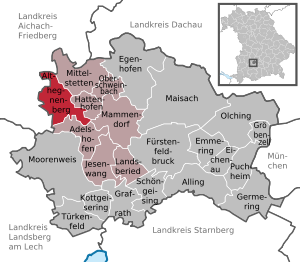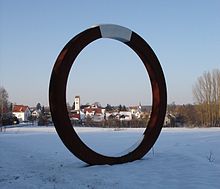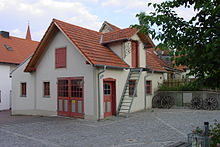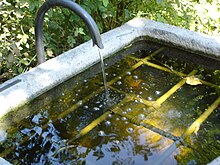Althegnenberg
| coat of arms | Germany map | |
|---|---|---|

|
Coordinates: 48 ° 14 ' N , 11 ° 4' E |
|
| Basic data | ||
| State : | Bavaria | |
| Administrative region : | Upper Bavaria | |
| County : | Fürstenfeldbruck | |
| Management Community : | Mammendorf | |
| Height : | 536 m above sea level NHN | |
| Area : | 16.09 km 2 | |
| Residents: | 2062 (Dec. 31, 2019) | |
| Population density : | 128 inhabitants per km 2 | |
| Postal code : | 82278 | |
| Area code : | 08202 | |
| License plate : | FFB | |
| Community key : | 09 1 79 114 | |
| LOCODE : | DE AHB | |
| Community structure: | 3 parts of the community | |
| Address of the municipal administration: |
Augsburger Str. 6 82278 Althegnenberg |
|
| Website : | ||
| First Mayor : | Rainer Spicker ( BI citizens' initiative ) | |
| Location of the Althegnenberg community in the Fürstenfeldbruck district | ||
Althegnenberg is a municipality in the Upper Bavarian district of Fürstenfeldbruck and a member of the Mammendorf administrative community . It is located around 14 kilometers west of Fürstenfeldbruck , 18 kilometers east of Augsburg and 40 kilometers west of Munich .
geography
The Haspelmoor nature reserve (geotope number 179R005) is partly located in the municipality.
The municipality has three officially named municipal parts (the type of settlement is indicated in brackets ):
- Althegnenberg ( parish village )
- Hörbach ( Kirchdorf )
- Lindenhof ( wasteland )
history
Until the church is planted
Althegnenberg was first mentioned in a document in 1096 as Haginiberc , which means something like "protected settlement on the mountain". Hörbach was first mentioned in 1127 as Huruuuinin , meaning “settlement on the swampy brook” (from the Middle High German word hurwin for “swampy”). On the south-eastern edge of the village is the castle hill - an artificially raised moth that was surrounded by a moat. In the 12th and 13th centuries, the small castle of the Hegnenberg family, the Burgstall Althegnenberg , stood on the castle hill . The Hegnenbergers were a ministerial family of the mighty Guelphs . Engelschalk and Hermann von Hegnenberg were first mentioned in 1192; They came from Upper Swabia ( Schmalegg near Ravensburg ) and had to protect the Welf Monastery of Altomünster . In their time they were sought-after advisors and confidants of the mighty. They witnessed the coronations of kings, the founding of monasteries ( Fürstenfeld ), and legal transactions by the church, the sovereign and the nobility. With the death of Welf VI. In 1191 the whole of Lechrain passed to the Staufer . Among these, the Hegnenbergers rose to become Reich Ministerials. Only after the tragic end of the young King Konradin (1268) did the possessions of the Hohenstaufen in Lechrain pass to the Wittelsbachers and thus came to Bavaria . The Hegnenbergers were also loyal servants and advisors to the Wittelsbach family. They had extensive possessions in Bavaria and Swabia . Around 1300 they left their ancestral seat and built their new Hofhegnenberg castle four kilometers to the west . Hegnenberg became Althegnenberg. During this time the closed Hofmark Hofhegnenberg was created , a legal structure of seven villages, namely Hofhegnenberg, Althegnenberg, Hörbach, Hausen, Steindorf, Tegernbach and, at times, Steinach. The lords of the Hofmark were the Counts of Hegnenberg-Dux from 1540 to 1848 .
In the course of the administrative reforms in Bavaria , the municipal edict of 1818 created the municipalities of Althegnenberg, which consisted of the districts Althegnenberg and Lindenhof, and Hörbach.
Incorporations
Hörbach came to Althegnenberg on July 1, 1972 as part of the municipal reform.
Population development
Between 1988 and 2018 the community grew from 1,392 to 2,024 by 632 inhabitants or 45.4%.
| year | 1840 | 1871 | 1900 | 1925 | 1938 | 1950 | 1961 | 1970 | 1987 | 1991 | 1995 | 2005 | 2010 | 2015 |
| Residents | 232 | 419 | 477 | 535 | 534 | 991 | 985 | 1083 | 1368 | 1496 | 1627 | 1845 | 1860 | 1986 |
politics
Municipal council
| year | CSU | SPD | FDP |
Voting group citizens' initiative |
Hörbach village community |
Unity Althegnenberg-Hörbach |
Alliance 90 / The Greens | total | Voter turnout in% |
|---|---|---|---|---|---|---|---|---|---|
| 2020 | 2 | 2 | n / A | 5 | 2 | n / A | 3 | 14th | 69.24 |
| 2014 | 3 | 3 | n / A | 4th | 2 | n / A | n / A | 12 | 60.29 |
| 2008 | 3 | 3 | n / A | 4th | 2 | n / A | n / A | 12 | 68.4 |
| 2002 | 3 | 2 | 0 | 4th | 2 | 1 | n / A | 12 | 73.0 |
mayor
Rainer Spicker (citizens' initiative) has been mayor since May 1, 2020; he was elected on March 15, 2020 with 67.58% of the vote. Its predecessors were:
- 2014–2020 Paul Dosch (Voting Group Citizens' Initiative)
- 2002–2014 Reiner Dunkel (SPD)
tax income
The municipal tax revenue in 2006 amounted to € 1,175,348. An active local Agenda 21 group has existed since 1997 .
coat of arms
The description of the coat of arms reads: obliquely divided by silver and blue; above a slanted red sheep shears, below a growing silver horse's head with a golden mane.
Economy and Infrastructure
Economy including agriculture and forestry
In 2012 there were 116 employees subject to social security contributions at the place of work and 662 at the place of residence. In addition to various commercial enterprises, there were eleven farms in 2010 with an agriculturally used area of 382 ha. Of this, 326 ha were arable land and 56 ha were permanent green space.
Since October 2006 there has been an eleven hectare photovoltaic system in the community . It has a peak output of 2.2 megawatts and can thus supply around 700 households with solar power.
traffic
Bundesstrasse 2 runs through Althegnenberg . The place is on the Munich – Augsburg railway line with a stop for regional trains, which is in the MVV for trips to Munich and in the AVV to Augsburg .
education
There are the following facilities:
- kindergarten
- primary school
- Community library with more than 6000 media
Culture and sights
Parish Church of St. Johannes d. Baptist in Althegnenberg . The stately parish church stands in the middle of the village . It was built in 1938 by Thomas Wechs . The baroque altars were taken over from the previous church. Before that there was a Romanesque church. A consecration stone and a very rare memorial stone , both from the middle of the 11th century, bear witness to this .
Mountain chapel in Althegnenberg ( Burgstall Althegnenberg ). Friedrich Peter Freiherr von und zu Hegnenberg-Dux had a Marienkapelle built on the castle hill , which was once surrounded by a moat and on which the Hegnenberg castle once stood. The “mountain chapel” as it is popularly called, was built by the Bregenz master builder Jobst Mospruckher as an octagonal central building that is modeled on the Altöttinger Gnadenkapelle. A regionally significant pilgrimage developed for this Marienkapelle , so that in 1762/63 the chapel had to be extended by a nave . In 1883 the interior was given a colorful, decorative setting in keeping with the times. Today, the mountain chapel of the community Althegnenberg owned and run by the Lutheran parish as a place of worship used.
Parish church of St. Andreas in Hörbach . Longhouse from the Romanesque (typical round arch frieze on the south side), the choir from the late Gothic and the western extension from 1909. Baroque interior with sculptures by the Landsberg baroque sculptor Lorenz Luidl . Outstanding lifesize Renaissance - crucifix from around 1500. In the entrance to the church is a fragment of a Roman grave stone walled, which has been found in the church expansion in 1909 in the foundation of the church.
Anabaptist fountain Hörbach . The Anabaptist Fountain is located in a small square next to the church. It is supposed to commemorate the execution of four Hörbacher Anabaptists (also called Anabaptists) in 1527.
The village of Hörbach received a gold medal in the competition Our village should become more beautiful - our village has a future for Upper Bavaria in 2000 and a silver medal in the Bavarian competition the following year.
The oldest cabaret in Upper Bavaria, the Hörbacher Monday Board, has existed in Hörbach since 1975 .
Soil monuments
literature
- Toni Drexler , Angelika Fox: Althegnenberg - Hörbach. Contributions to the history of the Althegnenberg community. St. Ottilien 1996.
- Toni Drexler, Walter Irlinger, Rolf Marquardt (eds.): Fürstenfeldbruck district - archeology between Ammersee and Dachauer Moos . Theiss, Stuttgart 2007, ISBN 978-3-8062-2079-7 .
- Alexander Zeh: The mountain chapel in Althegnenberg . In: Amperland , 1989, pp. 370-373.
Web links
- Homepage
- Entry on the Althegnenberg coat of arms in the database of the House of Bavarian History
- Althegnenberg: Official statistics of the LfStat (PDF; 1.7 MB)
Individual evidence
- ↑ "Data 2" sheet, Statistical Report A1200C 202041 Population of the municipalities, districts and administrative districts 1st quarter 2020 (population based on the 2011 census) ( help ).
- ^ Mammendorf administrative community: Mayor Rainer Spicker. Retrieved May 14, 2020 .
- ^ Althegnenberg community in the local database of the Bavarian State Library Online . Bavarian State Library, accessed on September 10, 2019.
- ^ Wilhelm Volkert (ed.): Handbook of Bavarian offices, communities and courts 1799–1980 . CH Beck, Munich 1983, ISBN 3-406-09669-7 , p. 466 .
- ↑ https://www.merkur.de/lokales/fuerstenfeldbruck/reiner-dunkel-altbuergermeister-ernannt-3941670.html










